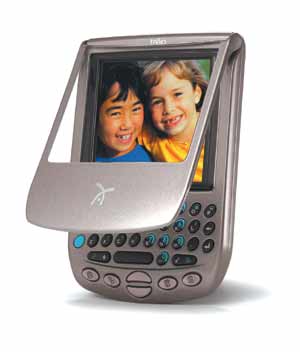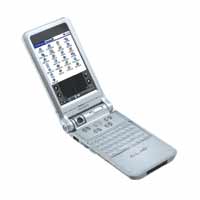Keyboards in hot demand as PDAs move to next
generation
by Alan Zisman (c) 2002 First published
in Business in Vancouver
, Issue #666 July 20- August 6, 2002: GearGuide
column
Gone
are
the days of sharp sticks and alien alphabets
Remember
Newton, Apple's pioneering
but ultimate failure of a personal digital assistant? It promised
to recognize users' handwriting, but its lack of accuracy (at
least when first released; later versions were much better)
made it the butt of a week's worth of 1993 Doonesbury
cartoons.
While
keeping
Newton's stylus, used for on-screen input, Palm produced the first big PDA
hit by turning the model around.
Instead of training a little computer to recognize the user's
handwriting, Palm users get trained to write in a way that
their PDA can understand.
But
a number
of recent PDA models have moved away from handwriting recognition
entirely, opting for something innovative: keyboards. Perhaps
imitating the thumb-keyboard in the popular wireless Canadian RIM Blackberry are PDAs
from Handspring, Sony, and Sharp.
Treo's
affordable
colour
 April's GearGuide looked at
Handspring's
Treo 180, which combines a cell phone with a Palm-compatible
PDA. Initially, Handspring released two models, the Treo 180G
with traditional Palm-style pen input, and the 180 with a
little keyboard. With US-sales well over 10 to one for the
keyboard model, the 180G was never introduced in Canada.
April's GearGuide looked at
Handspring's
Treo 180, which combines a cell phone with a Palm-compatible
PDA. Initially, Handspring released two models, the Treo 180G
with traditional Palm-style pen input, and the 180 with a
little keyboard. With US-sales well over 10 to one for the
keyboard model, the 180G was never introduced in Canada.
Now
Handspring
has released two new Treos. Both the Treo 270 (not yet available
in Canada) and Treo 90 (about $500) offer nice colour screens
while keeping the keyboards. The 270 includes the phone; the
Treo 90 leaves it out. The result is among the smallest and sleekest of
the Palm-powered units.
Like
all the
Treo models, it also turns its back on Handspring's innovative
Springboard add-on slot, in favour of a smaller Secure Digital
slot, also found on some Palm models, for adding memory, eBook
content or devices such as GPS or Powerpoint presentation viewers. But
it's the mini-keyboard that makes it stand out from the pack of basic
colour-screen Palm-powered PDAs.
CliE
pushes
the
envelope
 Sony's CliE series of PDAs also run the Palm operating
system,
but with the sorts of multimedia features that are more often
found on Pocket Windows handhelds than on Palm-powered PDAs.
Sony's CliE series of PDAs also run the Palm operating
system,
but with the sorts of multimedia features that are more often
found on Pocket Windows handhelds than on Palm-powered PDAs.
The
$1,000
CliE PEG-NR70V continues in that tradition. Unlike the Treo
90, it's pretty big, but then again, it's got a lot of features
in its clamshell case. Sony packs four times as many pixels as Palm or
Handspring into its full-colour screen for better photo display. The 66
MHz processor is twice as fast as what's found
in most Palm-type units. It can play MP3 audio or display
video. There's even a 320x240 resolution digital camera built-into
the case. Tiny Sony Memory Stick cards allow storage of up
to 128 Mb of audio, video, or other documents.
And
again,
there's a keyboard. This time, it's on the bottom section of the
two-piece clamshell; Graffiti fans can swing it up out of the way,
letting them enter data into the CliE using a stylus. This CliE is
expensive, but it's the most feature-packed Palm-powered PDA available.
Sharp's
Zaurus
goes
its own way
While
Handspring
and Sony are both building their PDAs using the Palm operating
system, Sharp's new Zaurus SL-5500 (about $700) uses the open-source
Linux system, scaled down to work on a pocket-sized computer.
Once
again,
there's a keyboard. In this case, part of the case slides
down, making the keyboard accessible when wanted. If your thumbs get
tired, you can also use its built-in handwriting recognition. The
320x240 pixel colour screen, 206 MHz StrongArm processor,
and both CompactFlash and Secure Digital expansion slots make
its hardware specs the equal of most of its Pocket Windows-competition.
Sharp
scores
points for making Linux a competitor to Palm and Microsoft's
Pocket Windows in the PDA market. Like Linux on full-sized
PCs, this version is almost infinitely customizable. And there's
a surprising amount of software available for such a new system.
There are problems reported, however, synching its data with
Windows PCs, no Mac support, and ironically, no software included to
sync with Linux desktops.
